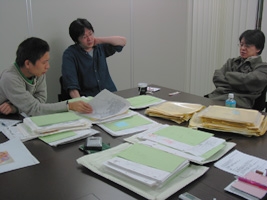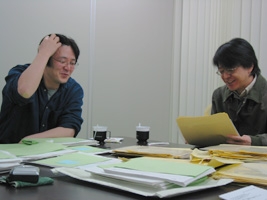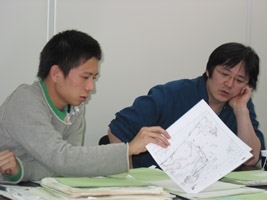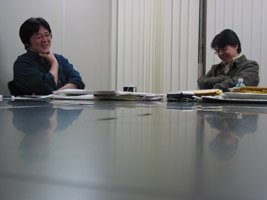Retrospective Chat Session

Otogi Zoshi was aired in Japan from July 2004 to March 2005 on NTV, and the DVD is currently on sale in Japan and other countries. It's been almost a year since this program was completed, and we have asked both the director Mizuho Nishikubo and the character designer/animation supervisor Kazuchika Kise to join us again to look back on the project. The producer Tetsuya Nakatake will host the chat session.
MIZUHO NISHIKUBO Profile
Director. Born on January 5, 1953. His main directive credits include the TV series Red Photon Zillion and Heaven Wars Shurato, the OVA Video Girl Ai, and the game series YaruDora. He often collaborates with Mamoru Oshii as sequence director in such movies as Patlabor, Ghost in the Shell and Innocence.
(picture right)
KAZUCHIKA KISE Profile
Character Designer and Key Animation Supervisor. Born in Osaka Prefecture on March 6, 1965. After working at Anime R, he joined I.G Tatsunoko (now Production I.G) in its early days. His filmography includes Blue Seed (TV Series), Patlabor: The Movie, Patlabor: The Movie 2, Ghost in the Shell, Jin-Roh, Blood: The Last Vampire, Sakura Wars: The Movie and Innocence.
(picture center)
TETSUYA NAKATAKE Profile
Line Producer. Born in Ibaraki Prefecture on November 16, 1979. His first job at Production I.G was the PS2 game Surveillance. For the animation sequence of the PS2 game Tales of Destiny 2 he was promoted to production manager, and then became producer for the TV series Otogi Zoshi. His most recent title is the feature Tsubasa Chronicle - The Princess of the Birdcage Land.
(picture left)
Part 01

Nakatake: This is going to be a retrospective chat session on Otogi Zoshi marking a year after its completion. We have invited the director Mizuho Nishikubo, as well as Kazuchika Kise, who was in charge of character designs and supervised the animation, and also Michiko "Micchi" Yamakawa, the PR rep. I will be the moderator. First of all, could you tell us what you can remember about the days you were working on Otogi Zoshi?
Kise: Well, it coincided with a time that I was obviously hooked on Korea. I was in Korea for a while immersed in a project called Van Helsing Animated, and when I returned to Japan, I kept on working at the same pace on this project. I actually collapsed. (sweats)
I was also in charge of character designs. Mitsumoto-san, the production chief, always yelled at me, "Create character files that would make people want to draw!" What happened was that everyone wanted my files, but nobody wanted to work with them. (laughs)
Nishikubo: That's well said.
Kise: For me, at the start, I felt I was given a good excuse to draw swords. The Heian Chapter was all right, but when we reached the Tokyo Chapter, they no longer used swords. So I only drew a few character files for the Tokyo Chapter. I would say that I lost interest along the way. (laughs)
Nakatake: Let me start with Kise-san. Can you comment on your work as an animation supervisor?
Kise: I don't like to review the work again after it's finished.
Nishikubo: I've worked a lot with Kise, feature anime included, but he hardly ever reviews the work again after the first preview. I haven't seen Otogi Zoshi since the first preview either.
Yamakawa: Nishikubo-san has viewed it over and over again for "director check" inspection purposes, so maybe he feels that's enough.
Nishikubo: Not really. If I see it once and I OK'd it, then my work is over. (laughs) Anyway, I had seldom seen Kise work so hard in my life. Especially during the first half of Otogi Zoshi.
Kise: I was really working hard during my first three years in the industry. Very intensive, schedule-wise too. (laughs)
Nishikubo: He was working quite intensively; really, I had seldom seen him work like that. On top of that, I initially thought his work as an animation supervisor would be over after six episodes. After that, we thought we'd ask him to inspect every five episodes or so.
Kise: You can't complain now. I've done it all already.
Nishikubo: Well, it sure was amazing. That's my biggest impression. My expectation was completely off there. And I should also mention that key animators used to say that the characters for Otogi Zoshi were difficult to draw. Is there any reason for that?
Kise: They are quite unique, actually. Composition and details. They were not drawn in a way animators usually draw. To put it simply, there are a lot of "unnecessary lines." Lots of confusing, unnecessary lines. In terms of the anatomy of the human body, we would say, "there's some mass here, which creates this line, and it comes out here", but when it comes to animation, the lines obstruct the movement.
Nakatake: Could we say that that makes the uniqueness of the characters?
Kise: Key animation was done that way, so we must make the most of it.
Nishikubo: Sho-u Tajima said, "If Kise-san's in charge, he can alter the characters and make them more animetic". So we had his permission. And I surely passed his message on to Kise. But somehow I did have this bad feeling when Kise said he liked Tajima-san's drawings.
Kise: Yup.
Nishikubo: I don't think the lines were reduced in the process of modifying character designs for anime. When I look at it again now, I can't believe how we could have done it.
Part 02

Nakatake: As was the case with the first episode, the ninth episode was also significantly revised by Kise-san.
Kise: Layouts for that episode had lots of close-ups of people, you know. And close-ups had never been my choice. (lol)
Nakatake: There is a scene where Kise-san only modified a piece of smoke.
Yamakawa: How about the characters?
Kise: Characters were long shots, so I thought they were fine. They stopped using bust shots. Instead, I felt like moving this cut scene and that...
Nakatake: And that cat in Episode 14.
Kise: At the very beginning, at the time of layout check, the entire layout sketch had to be presented, so I drew a cat just for convenience. What they initially asked me to do was to check the scenes with the cat. So I just kept my drawing, but as we ran out of time, I ended up drawing the key animation myself. (lol)
Nakatake: Now, let's begin with the part Shinya Ohira worked on.
Kise: I think Ohira-san really did a great deal of work. He personally told me he liked period stories.
Nakatake: Nearly at the end when Ohira-san had to move on to another project, he was nice to hear him say, "I wished to work on Otogi Zoshi a little more."
Kise: We were already working on the Tokyo Chapter. Anime fans would jump at this inside story.
Nakatake: Who'd ever guessed he'd turn out to be like that?
Kise: His old drawings are completely different.
Nakatake: We've asked him to draw a tsunami scene in Episode 6, and the scene where a dragon emerges in Episode 12.
Nishikubo: Sequence director Bob (aka Hideyo Yamamoto) was really amazed to see his own storyboards transformed into such stunning key animations. He said, "Wow. How could this guy do it?" He was astounded. But this is one of the things that make this work exciting, isn't it?
Kise: It's necessary to expand your imagination from a storyboard and draw, you know.

Nakatake: Episode 21 comes back to me.
Kise: We just didn't have enough time. Everyone was having a difficult time.
Nishikubo: The second half of the series had to be done on a really tight schedule.
Kise: Every time I came across Mamoru Sasaki on the street - he was one of the animation supervisors -, he asked, "Are you OK with that?" What could I say to that? You know, I drew all of the key animations from some point on. It made me feel at peace to draw cats, at least.
Nakatake: Torakuma plays an important role in Episode 25.
Yamakawa: Sound director Wakabayashi-san and all the cast members at the recording studio were excited. Everyone said, "The cat's so cute!"
Nishikubo: You've checked all the cat scenes without exception.
Kise: I did check Urabe's close-ups too. Speaking of Urabe, people found her difficult to draw, because of her broad shoulders. They all turned out too narrow, so I corrected each one of them to make her figure look better.
Nakatake: For Episode 12, I'd asked Toru Okubo to do the key animation.
Nishikubo: I didn't know he drew key animation too. He actually had a hard time supervising the already-drawn key animations. He needed nothing but patience. (lol)
Kise: He used to say, "I didn't know animation supervising was this intense."
Nishikubo: But I bet he's feeling he could do anything after this project. (lol)
Nakatake: Right. I heard Otogi Zoshi was a real challenge.
Nishikubo: Anyone who has done animation supervising an I.G anime says so.
Kise: That might be true. You're in a very demanding environment and you learn to draw key animation at such high standards, but outsiders donât expect that much.
Nishikubo: It depends on the atmosphere of the company, I suppose.
Kise: For instance, when keeping to the schedule is the priority, people sometimes get a lot of additional staff to do the job.
Nishikubo: I should have returned some of them for a retake, but if people can't draw anyway, that's a waste of time. I used to be persistent before and returned the drawings something like three times over, but at the end of the day, we ended up saying, "Thanks, Kise, we'll leave it up to you!"
Part 03

Nakatake: Is there anything else that you recollect?
Kise: Chiba-san from P.A. Works, who also supervised animation for us. I liked his drawings in Episode 20. You know, the lips were visibly thicker.
Nishikubo: That's right. Especially the girls. Surprisingly sexy somehow.
Kise: There was something particularly interesting about it. His key drawings are interesting too. I noticed that he had done the key drawings himself in the latter portion.
Nakatake: Is there anything that you wanted to experiment a little further, or something that you've left undone?
Kise: None.
Nakatake: You are straight to the point for a Japanese. (lol)
Kise: Well, I don't know whether I should say I've left anything undone, but I certainly wanted to do more of the real work. I mean I wasn't allocated an episode to work on. I would never want to be the chief animation supervisor again. But I am supposed to do something similar once again. (lol)
Nakatake: You mean you would wished to supervise a certain number of episodes rather than work as a chief supervisor throughout the whole series?
Kise: Yep, I wanted to do a solid job on single episodes.
Nishikubo: To tell you the truth, I wanted Kise to supervise each episode from layout to the end. But if Kise wasn't the chief supervisor, we wouldn't have gotten continuity for the characters for the entire series to be. We could have faced a tougher situation.
Kise: Ha-ha, ha. (lol) At first, I thought I only had to do the first five or six episodes as chief animation supervisor, but it didn't work out that way.
Nakatake: Well, you see, we heard that the animators were complaining that the characters were difficult to draw. Nevertheless, there were a couple of people who joined the team because, as they said, "Kise-san did the original character design." I must admit that was so happy. That was Chiba-san and Sasaki-san.
Kise: Wow, really? It would have been all right if it was a period drama. Poor them.
Nakatake: Don't say that.

Kise: But they told me in person, "I thought I could do a period drama, but we're doing contemporary (Tokyo Chapter)."
Nishikubo: So I told them in the beginning, "Why didn't you come earlier? No one wanted to work on it, because it was a period drama."
Nakatake: Ha-ha-ha, ha. (sweating)
Nishikubo: Yeah, it was difficult to do the period outfit and things like that in the first place. I really wanted to tell them, "You should have come earlier!" (lol)
Yamakawa: Kise-san, you said you wanted to do a real chanbara (sword fight) show.
Kise: I'm still thinking about it. I would like to do a very restrained chanbara. Not even jumping. I've always wished to do that.
Nishikubo: Like the director Kon Ichikawa's film, Matatabi (The Wanderers)? I'd assume if you say you want to direct one yourself, they'd let you at least once.
Nakatake: Do you really like chanbara, Kise-san?
Kise: I like period tales. It's a little different from the usual period dramas. In the period dramas, we would only have the chanbara fights, but with period tales, we would have to portray more of everyday life and culture.
Nakatake: Then, a story of a samurai might just be right.
Kise: I'd rather go for a story of townspeople.
Nakatake: Really? I think that's a good idea. It suits you.
Nishikubo: I think at some point, you might get a chance to do something like that at Production I.G.
Nakatake: I don't think that's impossible, sir.
Part 04

Kise: When I was in South Korea, I used to say, "I'd like to make a Korean War anime." I met Director Nam there. When we were chatting over a drink, I said, "I'd like to do an anime about the Korean War." He was surprised, "Really? How could a Japanese think of something like that?" He thought it was taboo for us to talk about it. He said, "I'm surprised to meet a Japanese who would say something like that." If a Korean director would direct such an anime, I'd hope to join the project as an animator.
Nakatake: Oh, I see. And what is it that you'd like to portray?
Kise: A drama of people. I'm fed up with lavish stuff. That's all I've done so far. Maybe I'm getting old.
Yamakawa: You sure sound like you're settling down. (lol)
Kise: I've had enough of flashy things. I'm getting bored. I can no longer get excited with these. I'd let my younger staff take care of them.
Nakatake: How about you, Nishikubo-san? Do you have any thoughts?
Nishikubo: I'd like to do an anime about music. To tell you the truth, I'd like to pick a topic from the period immediately before or after the war, such as the "2-26 Incident" and do a serious work. But it's a bit tricky as to whether animes are appropriate for those kinds of topics. I'm not sure if there's a rationale to do it in an animation format.
Kise: If you're looking for something extraordinarily real, it might be easier to do it with a live-action.
Nakatake: I don't think so. If you look at the opening scene of the Tokyo Chapter of Otogi Zoshi, I was genuinely impressed with Nishikubo-san's work.
Nishikubo: You're talking about Tetsuya Nishio. He did it.
Kise: Nishio did everything from the storyboards to the key animations.
Nakatake: Yep. The editing finished at about midnight. It came out fabulously, so I had to call Nishio-san even though he might've been in bed. I said, "It's fantastic! Amazing!" He answered, "What? What are you talking about?"

Kise: That work got good acclaim. I think I only did little changes to the key animation. I changed the layout a bit, but when I got it back again, it was redone nicely. It was really an easy work on my part. (lol)
Nishikubo: If only everyone was like that. But we couldn't afford to have highly talented people like him all the time.
Kise: Well, people like him must take care of others besides their own work.
Nishikubo: I never thought Kise would say something like that. (lol) Kise now really takes care of his crew. But at first, I thought, "What a lazy guy!"
Kise: Well, it's also a lot of pressure for the one who is introduced as "a talented key animator."
Nishikubo: But when choosing someone, it's helpful to get that kind of information. When I look at the layout of the first chapter, I notice interesting young people like Naoyoshi Shiotani coming out.
Nakatake: A key drawings compilation book has just been published in Japan.
Kise: I hope that's helpful in some way or other. Personally, I didn't want to publish it. (lol) From our point of view, we don't want to see our past works. I don't know what others think. There might be the same feeling out there as me wanting to own a key animation book of other anime. So please get it and go through the book. And for those of you who have already done so, thank you.
Nishikubo: I'm surprised to see that all the key drawings are of a very high quality. Chief animation supervisor Kise has done a lot of work too. (lol)
Kise: Come on, tell me the truth. What do you think about it?
Nishikubo: It made me think as if I was looking at animations for a feature anime film.
Kise: Basically, the work we do is the same.
Nishikubo: And the rest boils down to, you know, how we're going to make a compromise regarding the budget and the schedule. I have a feeling there's not much difference whether it's a collection of key drawings from Innocence or Otogi Zoshi.
Kise: Personally, I hadn't done a TV series for a long while.
Nishikubo: It worked out perfectly. (everyone lol)
Kise: If you ask me, I was very grateful that I could draw Sho-u Tajima's characters in Otogi Zoshi. That alone made me feel great.
Nakatake: I think that says it all. And I would like to end this session here. Thank you everyone for participating despite your busy schedule.
(end)
© IG/VAP/NTV

![WORK LIST[DETAILS]](/contents/works/design/images/left_title.gif)



 terms of use
terms of use